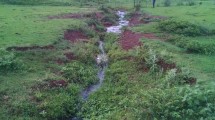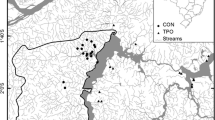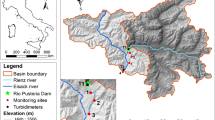Abstract
Aquatic invertebrates were sampled throughout an area of transition between a well-established reservoir and a perennial stream in the KwaZulu-Natal Midlands of South Africa. The visibly obvious separation of stream and reservoir was not reflected by the invertebrates. Communities overlapped in species, ranging from fast-flowing stream and moderate-flowing stream, through a transitional ecotone, which ran along the exposed reservoir edge and stream edges, to sheltered edges of reservoir and stream then to open reservoir. These features reflected the degree of water movement (whether from waves or riffles) and type of substratum, rather than visibly lotic or lentic conditions. The main aquatic ecotone between the open reservoir and the main stream was therefore not at the mouth of the stream but along the edges of both systems. The centre of the reservoir and centre of the stream, although physically connected, were quite different in their invertebrates and were separate ‘patches’ with a sharp boundary. They were faunistically connected through the communities of the edge ecotone. The ecotone acted like a semi- permeable membrane to the drifting stream fauna with movement back again apparently mostly in the air, suggesting a ‘patchy metapopulation’ model. Both the river continuum and boundary concepts were applicable to this multi-system. The ecotone did not show any edge effect and accords more with the ‘variegation’ than ‘fragmentation’ model. The great difference in patterns of pelagic, littoral and terrestrial communities has important implications for zoning of water bodies for different conservation and recreation activities.
Similar content being viewed by others
References
Alder, H.L. and Roessler, E.B. (1977) Introduction to Probability and Statistics, 6th edn. San Francisco: Freeman.
Barton, D.R. (1981) Effects of hydrodynamics on the distribution of lake benthos. In Perspectives in Running Water Ecology (M.A. Lock and D.D. Williams, eds) pp. 251–63. New York: Plenum Press.
di Castri, F., Hansen, A.J. and Holland, M.M. (eds) (1988) A new look at ecotones: emerging international projects on landscape boundaries. Biology International Special Issue 17. Paris: International Union of Biological Sciences.
Forman, R.T.T. (1995) Land mosaics. Cambridge University Press.
Forman, R.T.T. and Godron, M. (1986) Landscape Ecology. New York: Wiley.
Foster, G.N. (1991) Conserving insects of aquatic and wetland habitats, with special reference to beetles. In The Conservation of Insects and Their Habitats (N.M. Collins and J.A. Thomas, eds) pp. 237–62. London: Academic Press.
Gilbertson, D.D., Kent, M. and Pyatt, F.B. (1985) Practical Ecology for Geography and Biology. Survey, Mapping and Data Analysis. London: Hutchinson.
Hansen, A.J., di Castri, F. and Naiman, R.J. (1988) Ecotones: what and why. In A new look at ecotones: Emerging international projects on landscape boundaries. Biology International Special Issue 17. (F. di Castri, A.J. Hansen and M.M. Holland, eds) pp. 9–46. Paris: International Union of Biological Sciences.
Harrison, S. and Hastings, A. (1996) Genetic and evolutionary consequences of metapopulation structure. TREE. 11, 180–3.
Hill, M.O. (1979a) DECORANA — a FORTRAN program for detrended correspondence analysis and reciprocal averaging. Ecology and Systematics, Ithaca, New York: Cornell University.
Hill, M.O. (1979b) TWINSPAN — a FORTRAN program for arranging multivariate data in an ordered two-way table by classification of the individuals and attributes. Ecology and Systematics. Ithaca, New York: Cornell University.
Holland, M.M. (1988) SCOPE/MAB technical consultations on landscape boundaries. Report of a SCOPE/MAB workshop on ecotones. In A new look at ecotones: emerging international projects on landscape boundaries. Biology International Special Issue 17 (F. di Castri, A.J. Hansen and M.M. Holland, eds) pp. 47–106. Paris: International Union of Biological Sciences.
Ingham, D.S. and Samways, M.J. (1996) Fragmented or variegated landscapes? Light on a debate from epigaeic invertebrates in South Africa. Conserv. Biol. 10, 1353–58.
Jagomägi, J., Külvik, M., Mandar, U. and Jacuchno, V. (1988) The structural-functional role of ecotones in the landscape. Ekologia (CSSR), 7, 81–94.
Maitland, P.S. (1990) Biology of Fresh Waters. Glasgow and London: Blackie.
Marden, J.H. and Kramer, M.G. (1994) Surface-skimming stoneflies: a possible intermediate stage in insect flight evolution. Science 266, 427–30.
McIntyre, S. and Barrett, G.W. (1992) Habitat variegation, an alternative to fragmentation. Conserv. Biol. 6, 146–7.
Mohler, C.L. (1987) COMPOSE. A Program for Formatting and Editing Data Matrices. Ithaca, New York: Microcomputer Power.
Naiman, R.J., Décamps, H., Pastor, J. and Johnstone, C.A. (1988a) The potential importance of boundaries to fluvial ecosystems. J. North Amer. Benth. Soc. 7, 289–306.
Naiman, R.J., Holland, M.M., Décamps, H. and Risser, P.G. (1988b) A new UNESCO programme: research and management of land/inland water ecotones. In A new look at ecotones: emerging international projects on landscape boundaries. Biology International Special Issue 17 (F. di Castri, A.J. Hansen and M.M. Holland, eds) pp. 107–36. Paris: International Union of Biological Sciences.
Osborn, R. and Samways, M.J. (1996) Determinants of adult dragonfly assemblage patterns at new ponds in South Africa. Odonatologica 25, 49–58.
Pulliam, H.R. and Danielson, B.J. (1991) Sources, sinks, and habitat selection; a landscape perspective on population dynamics. Amer. Nat. 137 (Supplement), S50–S66.
Samways, M.J. (1989) Insect conservation and the disturbance landscape. Agric. Ecosyst. Environ. 27, 183–94.
Samways, M.J. and Steytler, N.S. (1996) Dragonfly (Odonata) distribution patterns in urban and forest landscapes, and recommendations for riparian management. Biol. Conserv. 78, 279–88.
Statzner, B. and Higler, B. (1986) Stream hydraulics as a major determinant of benthic invertebrate zonation patterns. Freshwat. Biol. 16, 127–39.
Strand, J.A. and Weisner, S.E.B. (1996) Wave exposure related growth of epiphyton: implications for the distribution of submerged macrophytes in eutrophic lakes. Hydrobiologia 325, 113–19.
Ward, J.V. and Stanford, J.A. (1979) Ecological factors controlling stream zoobenthos with emphasis on thermal modification of regulated streams. In The Ecology of Regulated Streams (J.V. Ward and J.A. Stanford, eds) pp. 35–55. New York: Plenum Press.
Waters, T.F (1972) The drift of stream insects. Ann. Rev. Entomol. 17, 253–72.
Webb, N.R. and Thomas, J.A. (1994) Conserving insect habitats in heathland biotopes: a question of scale. In Large-scale Ecology and Conservation Biology (P.J. Edwards, R.M. May and N.R. Webb, eds) pp. 129–51. Oxford: Blackwell.
Wood, P.A. and Samways, M.J. (1991) Landscape element pattern and continuity of butterfly flight paths in an ecologically landscaped botanic garden, Natal, South Africa. Biol. Conserv. 58, 149–66.
Yahner, R.H. (1988) Changes in wildlife communities near edges. Conserv. Biol. 2, 333–9.
Author information
Authors and Affiliations
Rights and permissions
About this article
Cite this article
SAMWAYS, M.J., STEWART, D.A.B. An aquatic ecotone and its significance in conservation. Biodiversity and Conservation 6, 1429–1444 (1997). https://doi.org/10.1023/A:1018397932257
Issue Date:
DOI: https://doi.org/10.1023/A:1018397932257




